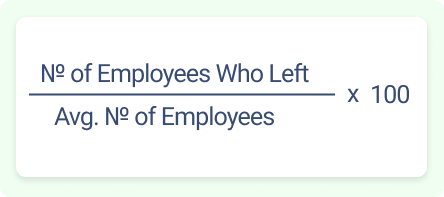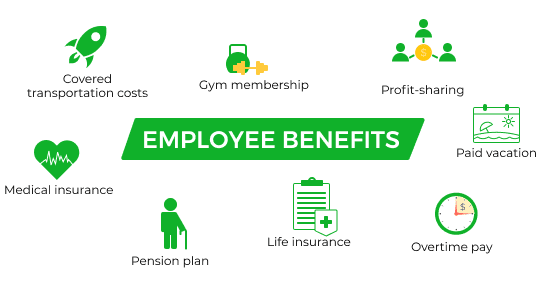It can be truly upsetting when a talented employee leaves a company. But do you know what’s an absolute nightmare compared to that? It’s when multiple team members decide to quit because something is wrong at the workplace.
To avoid such HR horrors, every employer needs to know how many workers they lost over a period of time and why it happened so exactly. Luckily, this task is easy to complete with the right approach to attrition rate measurement. Let’s see what employee attrition means and how to manage it correctly.

What Is Attrition Rate?
Attrition rate (aka churn rate) is the rate at which employees quit a company. To calculate it, you need to divide the number of people who left their jobs by the average number of staff members. The last step is to multiply the result by 100 to express the attrition rate as a % value:

Main Types of Employee Attrition
There are two primary types of employee attrition: voluntary and involuntary. The former means that an employee decides to quit themselves, while the latter implies that an employee was dismissed for any legal reason.
It’s pivotal for a business to track both types of attrition – they can point to the varying problems you have with your organizational culture or management practices and help you find some robust solutions for improvement.
Attrition vs. Turnover
Attrition and turnover are often used interchangeably. These concepts are pretty similar, indeed, but not necessarily the same.
Staff turnover measures the rate at which a business replaces departing employees with new ones. In other words, it’s mainly about filling in the positions that became vacant and not just about the number of employees who quit the company.
Staff attrition, in contrast, refers to instances when departing employees are not replaced by other professionals immediately (or ever). Such a situation doesn’t always affect a company’s size or stop it from growing. Yet when employee attrition prevents the business from achieving its goals, that’s usually a warning sign.
How to Measure Attrition Rate: Example
Suppose you’re running a hospital and want to calculate the attrition rate for the last quarter of 2021:
Step 1: Check how many health providers left the organization during October, November and December (e.g., 4).
Step 2: Determine the average number of employees for the selected period: identify how many team members you had at its beginning and its end, add these numbers and divide them by 2 (e.g., 41 + 37 ÷ 2 = 39).
Step 3: Use the above-mentioned attrition rate formula to measure your results (e.g., 4 ÷ 39 × 100 = 10%).
Step 4: Analyze the outcome against the industry average and the data you collected for previous periods.
For example, if the nationwide staff attrition rate in hospitals equals 19%, the rate of 10% means that your organization is in a pretty good position in comparison. However, for better insight, it’s also pivotal to contrast your current attrition rate with your previous results to see how the situation changes over time. Plus, you need to figure out how different attrition rates influence your company, which costs they entail, and what effects they have on team productivity. This way, you will understand which level of employee attrition is optimal for your unique business, when it brings in some risks and when not.
What Causes High Employee Attrition
Most people change jobs multiple times throughout their lives and do that due to myriads of personal reasons and external circumstances.
Some may decide to embark on the quest for self-realization, become full-time students or relocate to a different part of the country. Others may need to focus on their health or take care of their loved ones. And whenever that happens, there’s nothing you can do to stop employees from leaving. The problem arises only if your team members are pushed to quit due to some internal factors inherent in your organization.
Here are some of the main of them:
1. Defective hiring methods
Not everyone can make a great match with other members of your team and the organizational culture in general. Some candidates may also lack internal motivation to do their job well and don’t have the stamina and expertise to meet all the set performance objectives.
In other words, if you hire people who do not fit your team, workplace environment and business aspirations in the first place, you will likely see them leave the company very quickly.
2. Stressful work environment
If every day an employee has to deal with heavy workloads, put up with a micromanaging boss and go through the hell of the toxic work culture, their will to work cannot last long.
As research evidence shows, constant work-related stress increases the risk of many chronic conditions, including diabetes and coronary heart disease. It causes insomnia, depression and substance abuse. And above all else, severe stress and burnout make a person very unhappy with their job and life in general – that’s a situation anyone would want to get away from.
3. No prospects for professional growth
For many people, an opportunity to acquire new skills and advance in their careers is a vital need. And in case one can’t satisfy it, they get bored and discontented.
If a person doesn’t see the desired progression in their professional development and status over a period of time (and you give them no chance to move forward), what prevents them from changing an unpromising job for something more fulfilling?
4. Uncompetitive employee benefits and compensation
Fair compensation is one of the primary motivators for every hired person. The wages should be well-correlated with the level of effort put into work and aligned with the industry standard. Otherwise, every diligent employee will sooner or later start to feel used to their employer’s advantage and be tempted to quit the job.
In addition, it’s important to remember that a great organization rewards always its staff members with a reasonable number of employee benefits. And in case you don’t, the chance is high that your employees will swap you for an employer that takes better care of them.

Why Measuring Attrition Rate Is Important
Frequent and unplanned employee departures often have a negative impact on business performance and productivity. Hence, a high staff attrition rate can be associated with excess business costs. Besides, when a team member leaves and their position remains open for a while, you might be compelled to burden other employees with heavier workloads, which is bound to make them more stressed and less efficient in the long run.
The best way to prevent these problems and ensure your business continues to thrive is by taking employee attrition under control. Let’s see how to do that without a hitch:
How to Control Attrition Rate in Your Company
- Measure the attrition rate regularly to see how the trend is evolving over time and promptly undertake corrective measures when necessary.
- Collect attrition data for different business departments, teams, employee performance levels, job categories, etc. This will let you identify the parts of the company where employee attrition is higher and better comprehend the whys of the issue.
- Compare your attrition rate to a broader context and the industry-specific average. Such an analysis provides an insight into your competitive stance, internal weaknesses and strengths.
- Evaluate the impacts of employee attrition on your business: How much money do you lose when an employee leaves and their position remains open? How does their departure affect the speed and the quality of team performance?
- Determine the roots of high employee attrition. Ask your departing employees why they leave and document the info consistently.
- Address the causes of high staff attrition using appropriate and evidence-based methods.
Tackling High Employee Attrition: Best Practices
Depending on the reasons why employee attrition takes place, you may need to implement some of the following solutions to promote staff retention and reduce business risks:
- Fine-tune your recruitment process – Make certain you hire the right people who make a good match with your workplace environment.
- Improve the work culture – Nurture your relationships with employees and strive to make their time at work as enjoyable as possible. Try out some fun team building activities, refrain from micromanagement and never leave interpersonal conflicts between the staff members unresolved.
- Optimize workloads – Let your employees work at a normal pace and without too much pressure by setting realistic deadlines and allocating tasks fairly and smartly.
- Provide enough opportunities for growth – Develop some training programs to help employees improve their skills and promote the best of your team members to higher and better-paying positions.
- Develop a competitive benefits program – Offer paid time off, medical insurance, flexible work arrangements, and other valuable perks to your employees so that they feel your care and stay committed to your company longer.
Did you know that high employee absenteeism can also indicate that your employees are on the verge of quitting their jobs? Use actiPLANS to track your team members’ days off, get a profound insight into their absence data and read the warning signs early on.
Try actiPLANS in action at no cost at all – sign up for a free 30-day trial and keep absenteeism in check!




